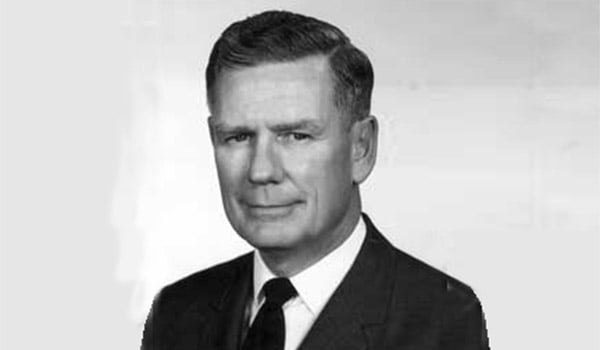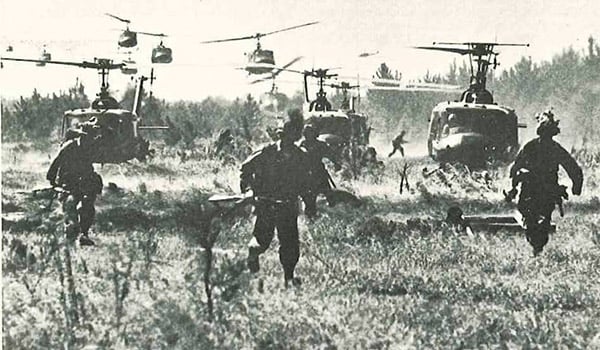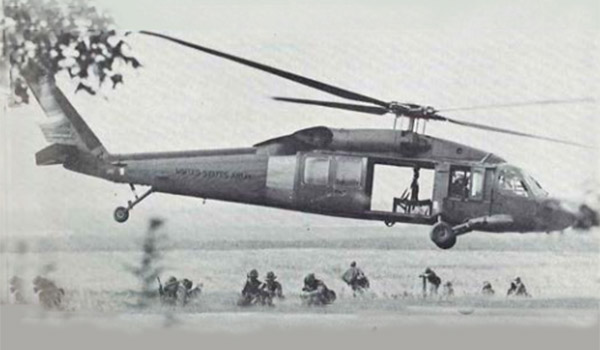
Army Aviation History / By General Hamilton H. Howze, U.S. Army (Ret.) — Source: Pages 53-56, Army Aviation, Vol. 25, Nos. 8 & 9, Army Aviation Publications, Inc., Westport, Ct., August-September 1977. / Edited By Mark Albertson
I have in the recent past, visited both the 101st and 82nd Airborne Divisions. In both cases I was much impressed by the appearance of officers and men: Lean, sturdy, smart looking soldiers, alert and neatly uniformed.

General Hamilton H. Howze
In each case also the division staffs were good enough to brief me on what they considered probable division overseas missions on certain international contingencies. In both cases the use (or non-use) of light aircraft was of obvious applicability: the numbers available and their employment would in large measure determine the outcome of the battle. And I came away from those briefings with an uneasy feeling that the Army has in some major respects forgotten much of what it once knew about airmobility.
It is true, of course, that the Army is spending lots of money to develop and bring into production two new helicopters, the UTTAS and the advanced attack helicopter. This is undeniable progress, but the quantities intended for purchase are not impressive, and neither are the number and size of units that are to be equipped with them.[1]
We ended the Vietnam War with two airmobile divisions; we now have one, and that one faces major cuts in strength. We have only one so-called air cavalry combat brigade, which is really not air cavalry but an aerial tank-destroyer force. It has considerable capability in that role, but along with the airmobile division it also may feel the chop.
I recently had access to the Army’s new operations manual, FM 100-5. There is periodic acknowledgment therein of the usefulness of light aircraft, but it is a patch job, with paragraphs apparently being added to an earlier but recent version. Quite obviously Army Aviation is not contemplated in the manual as a basic tool—as a strong, added, available and sometimes decisive capability, as it emphatically should be.[2]
The Answer: “Nothing.”
And a few months ago I talked to a number of young officers who were just graduating from the Advance Class at the Artillery School. I asked the group what the course had included about the techniques of artillery support of airmobile operations. The answer: nothing.

General Howze’s concern was that the Army was disregarding much of what it had learned about Airmobility./Army Aviation Magazine
I am guessing now, but I venture to say that Fort Sill has developed no special technique for the purpose. I am not guessing when I say that such a technique will be different from the normal, will require special training and will be very applicable to the winning of battles.
Because of the foregoing, because of periodically expressed concern about helicopter vulnerability, because of a pronounced dwindling of what used to be an enormous enthusiasm in the Army for airmobility and its practice, and because of current emphasis on the ground mechanization of practically everything, I think the Army is engaged in the implementation of a monumental error in judgment.[3]
We are, in the words of George Patton, taking too much counsel of our fears, and in consequence wrapping ourselves in armor and thereby losing flexibility and a big part of mobility. The helicopter is as vulnerable as a calf to a tiger if one employs it foolishly, but vulnerability will drop to acceptable levels if it is used cleverly and in conjunction with other weapons that can help it.
But given the tank and the armored personnel carrier, do we really need the helicopter as a combat vehicle? Sometimes a question can be answered best by a return to fundamentals. And the fundamental truth is that battles are won by a combination of firepower and mobility, and when the two get out of balance the result is a relatively ineffective fighting force.
Firepower has grown enormously since World War II, mobility much less so unless the helicopter is employed. Tanks and armored personnel carriers move at about the same rate as they did 30 years ago, and the act simply of providing more of them does not provide a given unit—say an armored or mechanized force—much more mobility than it had before.
But what can the helicopter do? I list a few things, things apparently overlooked now by much of the Army:
It can provide unparalleled battlefield mobility. It is an obstacle crosser; natural obstacles such as mountains, cliffs, rivers, dense forests, swamps, lakes and wadis; and artificial ones such as mine fields, contaminated areas, demolitions, artillery fire-swept areas, barbed wire and, on occasion, even enemy positions. Most battlefields are an agglomeration of obstacles. And only the helicopter can cross them quickly and easily—and substitute 140 miles an hour for 10 or 15.
It can provide surprise, often the key to victory, by the very quick and totally unpredictable shift of troops and firepower from one place to another.
It can provide, as nothing else can, very exceptional observation of battlefield terrain.
It provides a highly mobile and elusive platform for very powerful weapons.
It has excellent communications, and can serve as a very efficient messenger during radio silence or when radio frequencies are jammed.

Airmobility mainstay: The UH-60 Black Hawk, the Utility Transport Aircraft System replacement for the UH-1 Huey.
I must guard against overstatement, but I must say nevertheless that the helicopter is a magic machine. Given its unique capabilities and the ‘multi-quantum’ (if that’s an admissible expression) jump it provides in most of the essential and useful qualities of a military machine, it is simply inadmissible to dismiss it on the grounds that it may be shot down.
The approach must be to determine, by intense and frequent practice, how to use it properly. It is certainly unnecessary to specify that the helicopter must not be subjected to enemy fire, but it is true that a major part of its usefulness can be exploited without doing so. And when it must be exposed much can be accomplished by artillery and other weapons in protecting its flight path—if we learn now.
Right after the 1973 Arab-Israeli War, General Peled, the Chief of Staff of the Israeli Air Force, was quoted by the unbelievers as saying that the helicopter could not be employed at the edge of the battle on the Suez Canal. No doubt he was right—neither could any kind of aircraft, including fighters, in the extremely intense anti-aircraft environment that prevailed had the front moved a few miles to the east or west, as it was about to do when the cease-fire came.
Shortly after the war General Peled came to the United States. Why? To buy helicopters, particularly Cobras, for the Israeli Air Force.[4]
In its report issued in the late summer of 1962 the Army’s Tactical Mobility Requirements Board, sometimes known as the Howze Board, recommended that successor but smaller boards be convened every year to reexamine the Board recommendations and to see how things were going to the expansion of what the Board called an almost revolutionary development in ground battle tactics.
I would recommend now that this be done as soon as practically possible, because the action is exactly 14 years overdue, the new Board should do more than just a review; I would hope that it might be blessed by an almost unrestricted charter, as ours was. The Board should draw on the best tactical minds in the Army, on the other services, on operations analysis contractors, on industry as applicable, and on whatever other talent it might find, as ours did. The Board should be provided the terrain and the means to experiment informally with equipment and organization to its heart’s content, restricted only by time and, of course, reason, as ours was.
The Board’s chief purpose should be to bring airmobile doctrine up to date in view of new developments in aircraft and weapons, ground and airborne. New statements on feasibility and vulnerability are necessary—what will work and what won’t, and what tactics and techniques are necessary to take advantage of the helicopter’s enormous mobility and flexibility at acceptable rates of loss.
The Board should determine and recommend an optimum organization for the air assault division, and how many the United States should have. We habitually make the decision on the basis of 16 active Army divisions, forgetting the Marine divisions, the National Guard and Reserve divisions, and the fact that anywhere we fight overseas—Europe, Korea, the Middle East—we will be fighting alongside other and all non-airmobile divisions of our allies, wherefore the United States should have a disproportionally large number of airmobile forces.
I would hope also for a reconsideration of the air cavalry brigade, which I contend should be a homogeneous unit based on a platoon consisting of scout helicopters, two squads of riflemen riding in UTTAS or Hueys, and a couple of armed helicopters. This would be an extremely powerful little force, capable of enormous range of missions: reconnaissance, delay, rear area surveillance and protection, raids, the protection of a long flank, pursuit and exploitation, anti-tank action and others. In a desert area it could keep a couple of hundred square miles under constant surveillance, and effectively delay the progress of an enemy ground unit twenty times its size.
Each troop in my suggested brigade would have three identical platoons, each squadron three identical troops, and the brigade three identical squadrons. I believe each corps of our Army should have such a brigade. Given the assistance of artillery and engineers such a brigade could delay an assault by a Soviet armored corps—giving up ground slowly, meanwhile inflicting heavy damage—better than any reinforced armored or mechanized division in the world.[5]
Tree Tops: A Russian Orb!
And finally the Board’s activities should conclude with a walloping big demonstration to show the DOD, the Army, the Navy, the Air Force, and the Marines what can be done. If I may be permitted to boast, our demonstration in 1962 was impressive not only because it was quick and violent but also because it was convincing. None of the scores of senior officers who saw it ventured to attack it on the grounds of feasibility.
Let me conclude with the apology due from a man 12 years out of the active Army. But I cannot escape the conviction that the Army has not pursued with vigor the development of a highly useful capability at the same time that the Russians, once far behind us in equipment, doctrine, tactics and technique, are borrowing from our experience and markedly improving their ability to exploit that shallow but critically important layer of atmosphere just above the tree tops.[6]
Endnotes
- As a disciple of Clausewitz, Howze’s remarks here, in this short paragraph, should be considered pertinent, dealing as they do with a criticism of numbers, mass. . . Note Clausewitz himself:
“The best strategy is always to be very strong, first generally then at the decisive point. Therefore, apart from the energy which creates the Army, a work which is not always done by the General, there is no more imperative and no simpler law for Strategy than to keep the force concentrated. No portion is to be separated from the main body unless called away by some urgent necessity. On this maxim we stand firm, and look upon it as a guide to be depended upon. What are the reasonable grounds on which a detachment of forces may be made we shall learn by degrees. Then we shall also see that this principle cannot have the same general effects in every War, but that these are different according to the means and end.
“It seems incredible, and yet it has happened a hundred times, that troops have been divided and separated merely through a mysterious feeling of conventional manner, without any clear perception of the reason.
“If the concentration of the whole force is acknowledged as the norm, and every division and separation as an exception which must be justified, then not only will that folly be completely avoided, but also many an erroneous ground for separating troops will be barred admission.” See pages 276 and 277, Chapter XI, “Assembly of Forces in Space,” On War, By Carl von Clausewitz.
- Reminiscent, too, of the prevailing thought by man, of the tank as an infantry support vehicle, as was the case on the Western Front in France. But what the British and French produced were pop-bellied stoves able to troll a battlefield at 3 or 4 miles-per-hour. And depending on the terrain, these underpowered tracked sloths even had problems keeping pace with the walking infantry they were assigned to support. Later models, boasting on-road/off-road capabilities of 30 mph+, suitable armor and a competent gun and a trained crew, brought to the table something obvious to such people as Sir Basil Liddell Hart, J.F.C. Fuller, Charles de Gaulle, Heinz Guderian, especially when one mates the modern iron steed with the decisive Mongol cavalry tactics of the 13th century. For arguably, the mounted Mongol armies were the most successful military force in the entire history of Man due to their . . . Mobility.
- Precisely the criticism rendered by General James M. Gavin, of the U.S. and UN armies in North Korea in the fall and winter of 1950-1951. Armies practicing mechanization in an environment with a distinct lack of an infrastructure of viable roads. Therefore, an entire army riding in modern tanks and trucks was sent reeling by an enemy force (300,000 “volunteers” of the People’s Army of China) moving with the oldest mode of mobility in the history of Man, by foot, because this army assumed control of the countryside. Vietnam proved that with the helicopter, an army can control a countryside. Too . . .
. . . Napoleon can be added here as well with a point for contemplation: “Artillery is more essential to cavalry than to infantry, because cavalry has no fire for its defense, but depends upon the sabre. It is to remedy this deficiency that recourse has been had to horse-artillery, Cavalry, therefore, should never be without cannon, whether attacking, rallying or in position.”
This translates, of, course, in the modern sense, to the attack helicopter and/or ARA as used in Vietnam. See page 75, “Maxim LII,” Napoleon’s Art of War, by Napoleon Bonaparte.
- Reinforcement is not out of order here. While detractors of the helicopters might have been correct here, that it being vulnerable at the front, especially with the measures taken by the Egyptians to bolster air defenses for their armored thrusts, apparently General Peled of the Israeli Air Force was open-minded enough to believe that the attack helicopter had a place in a combined arms approach to dealing with an armored/mechanized threat.
- What General Howze is alluding to here, an airlifted brigade in every Army corps, to which he outlines its tasks, was alluded to, in a fashion, by James M. Gavin, in Harper’s magazine, twenty-three years earlier, 1954. Gavin offered telling criticism of the U.S. Army/UN invasion of North Korea, fall of 1950, a mechanized advance by which much of the forces were consigned to the poor road infrastructure of North Korea. The massive Chinese counterstroke saw a UN/U.S. retreat down the few roads available, pursued and outmaneuvered by an enemy moving by foot and in control of the countryside.
General Gavin offered that a competent mobile force, shuttled by light aircraft and helicopters, could seize and hold bridges and road junctures, attack the flanks and even the rear of the attacking enemy force, protect the flanks of the retreating friendly army, reconnaissance and/or observation, perhaps even direct supporting artillery fire.
- General Howze is quite correct that the Army should have conducted another Tactical Mobility Requirements Board, after a fourteen year hiatus. Perhaps consideration should have been given, too, to convening a major gathering every ten years, so as to critically study the pervious ten years and actively update doctrine, tactics, equipment. . . For the Army is no different than any other institution. It is made up of men. And as the human condition, shows, it gets apathetic, careless and opposed to change. The penchant to become reactionary is an affliction that stifles the mental edge, critical thinking. And this the Army cannot afford.
Bibliography
- Bonaparte, Napoleon, Napoleon’s Art of War, Barnes & Noble Books, Barnes & Noble, Inc., New York, 1995. Translated from the French by Lieutenant General Sir G.C. D-Aguilar, C.B.
- Clausewitz, Carl von, On War, Penguin Books, Middlesex, England, 1968. On War or Vom Kriege was originally published in 1832.
- Howze, General Hamilton H., U.S. Army (Ret.), Army Aviation, Vol. 25, Nos. 8 & 9, Army Aviation Publications, Inc., Westport, Ct., August-September 1977.








